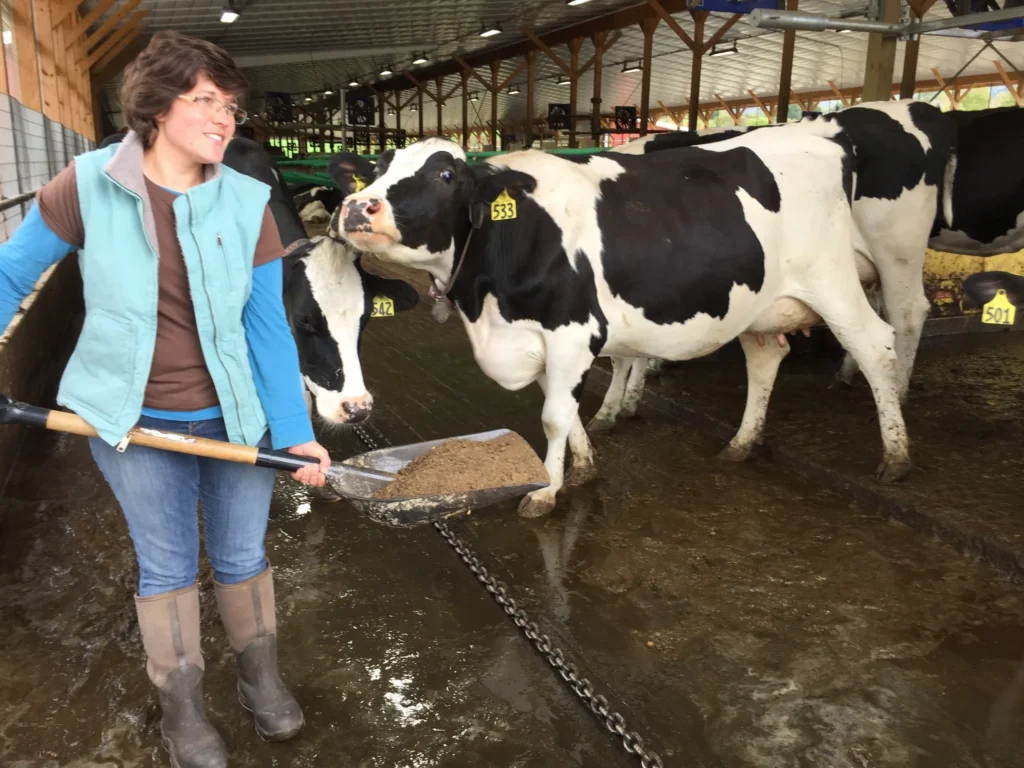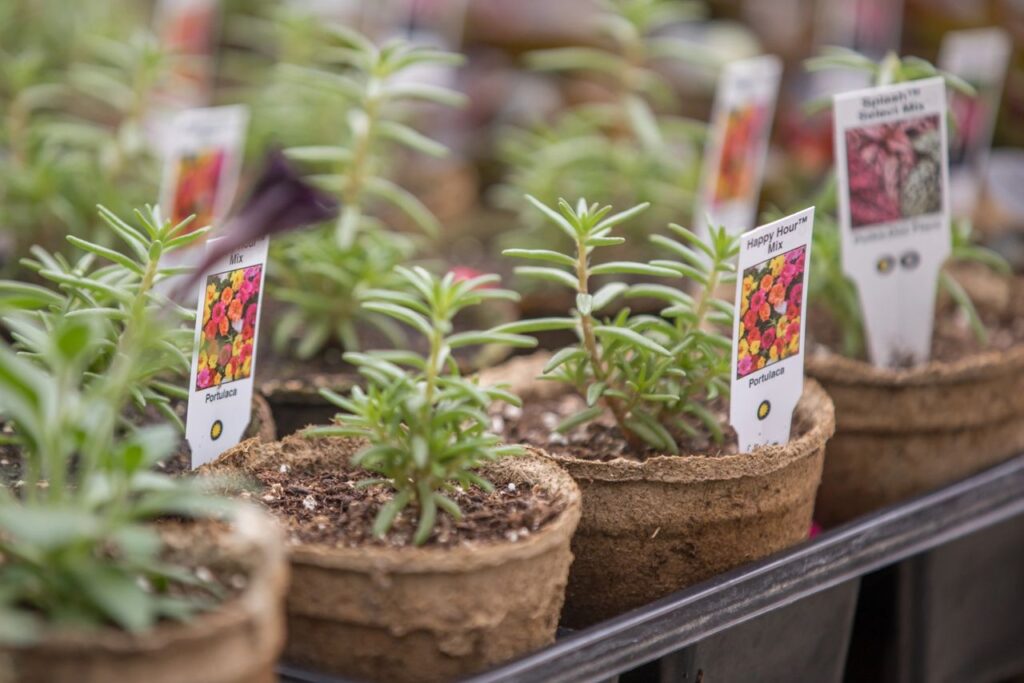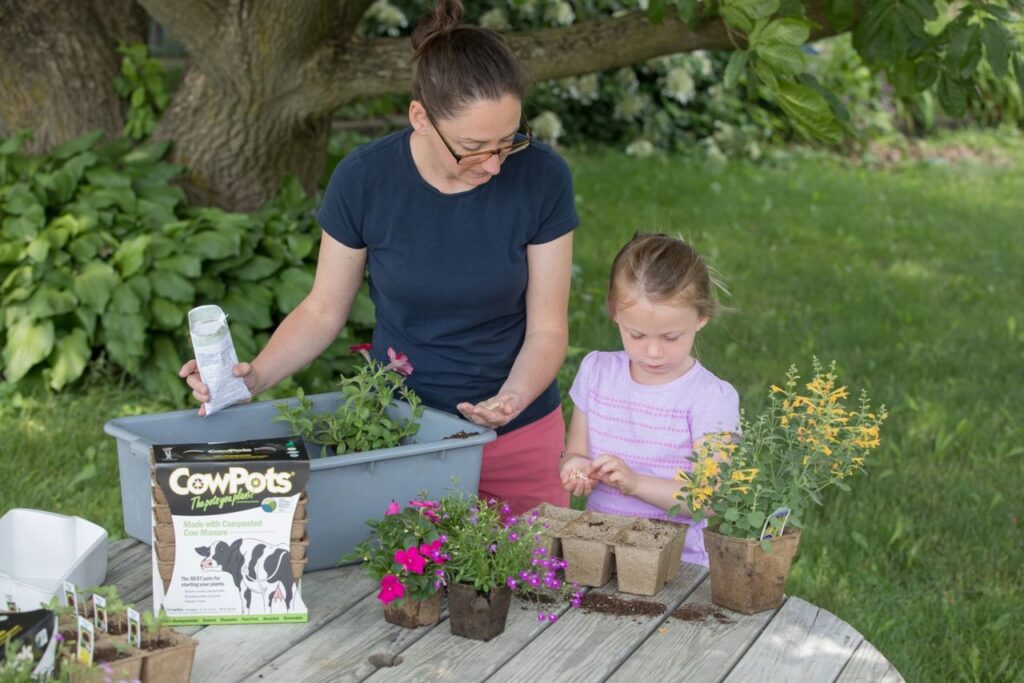
In 2007 our farm was featured on Discovery Channel’s Dirty Jobs as TV show host, Mike Rowe spent a day with farmer and CowPots inventor, Matt Freund. Together they went from start to finish following the path of manure and how it mooooves through the farm and eventually gets formed into a CowPot.
If you haven’t seen the episode, you should definitely check it out, Poo Pot Maker – Season 3, Episode 2. Here’s a sneak peak at a clip:
As Matthew says, “the reason it’s a CowPot is the cows gives us everything”. So let’s take a tour of how manure goes from cow to CowPot to your garden!

First, let’s talk about quantity and just how much manure we are dealing with here! Did you know that a cow produces up to 100 lbs of manure each day? And we have 350 cows on this farm, so this is a renewable resource we have a lot of! When managed responsibly, cow manure is a vital resource to the sustainability of dairy farms as it provides fertilizer for the fields that grow the crops to feed the cows.
Daily Collection
Our cows live in a free stall barn where they can roam around, go to the feed bunk when they desire a snack and visit the robotic milkers when they’re ready to be milked. The alley ways where they come and go is equipped with a giant floor squeegee that skims the floor, clearing the alleys of manure, 24 hours/day. The farmers will clean and scrape high use areas around the barn as well. All of this manure is pushed into an underground pit for temporary storage. Each day, we pump it into a truck that can either spread it into the fields or deliver it to the anaerobic methane digester. And that begins the next phase of manure processing on the farm.

Anaerobic Digester
One of our claims to fame 🙂 is that we have the longest continuously operating digesters in the country. Installed in 1997, this digester is a U vessel tank in the ground that holds the manure and keeps it at the optimal temperature that supports microorganisms. These ‘bugs’ are naturally acting and working in the cow’s gut and inevitably end up in her manure. Once contained in our digester, the design of this tank is that we can capture the gas that the microorganisms emit (methane) as they continue to “digest” the manure. The methane is burned as renewable energy sources on our farm to heat the house and hot water. The microorganisms can be temperamental especially in the winter when we have freezing temperatures. It takes quite a bit of management and insight to keep the biology of the digester content. Digesting manure is becoming more common across the US and is a unique way that dairy farmers are generating alternative energy resources on their farms.

Separation
Following digestion, the manure is pumped into the red building above the digester where it passes through a screen press separator. As the slurry is forced through the separator, the liquid can exit through the screen while the solids are forced out. The separated manure liquid is contained in an 800,000 gallon lagoon and stored until optimal time for pumping it to the cropland for fertilizer. A portion of the separated solids are delivered to the barn 2x/week as fresh bedding for the cows. The other portion of these solids are sent to the composter!

Composting
Using an invessel composter allows us to control some of the variables – like moisture and how often the pile is rotated. Composting is basically a heat treatment that kills potential weed seeds associated with raw manure and reduces the ammonia which is associated with the off-putting smell of poo. Each day the compost is turned with the use of gears and a timer and as it finishes it’s cycle, it spills out and is then ready for delivery to CowPots as digested, separated, composted manure solids.

Next Destination: CowPots Factory
Our factory uses pulp moulding technology. But instead of using fibers from trees, the standard resource in paper and cardboard making, we are using the fibers from our cows’ manure. With specialized molds, we form 15 styles of CowPots intended for seed starting, transplanting and growing.
We have also prototyped a variety of custom requests including survey disks, shallow dishes for indoor cultivation, hunting supplies, bait cups, packaging corners, etc.
Once the product is molded, it is set on a drying tray and loaded onto a cart. The cart goes into an oven and is dried to 0% moisture to remove any potential pathogens from the material. Dried product is then packaged in cartons and set on pallets to be stored in our warehouse.
CowPots have an indefinite shelf life as long as they are kept in cool and dry storage?

In your Garden
Whether you buy CowPots in bulk from a distributor and start hundreds of seeds or you just need 12 pots to grow some of your favorite kitchen herbs, CowPots are a renewable and recycled pot that will meet your growing needs. Our products have been designed to last up to 12 weeks in greenhouse growing conditions but break down quickly once planted in the ground.
CowPots have an NPK of 1-0-0 which is not sufficient to fertilize your plant but this nutrient package is what allows CowPots to break down faster than other biodegradables once planted in the ground. Manure is a soil amendment that also attracts earth worms and microorganisms. When those soil critters are incentivized to visit the site of your plant, they also bring important bioactivity to help your plants thrive. For these reasons, we encourage you to plant the entire CowPot in the ground, without crushing or tearing it. The roots will continue to grow through the porous walls and the soil critters will thank you for delivering a unique form of manure and nutrient to your garden bed.
From Cow to CowPots to your Garden!


